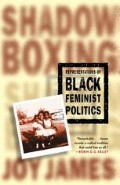Abstract
Political scientist Cedric Robinson notes that the image of Angela Davis as fugitive (we might also add former Panther leaders Kathleen Cleaver and Elaine Brown) became commercialized and sexualized in the Coffy/Cleopatra Jones blaxploitation films of the 1970s—the armed, revolutionary black woman as embodied by the stereotypes (and phenotypes) projected on celluloid of the “murderous mulatta.”1 This icon, a standard feature in film, has mutated and expanded in the 1990s to encompass domesticity. Whereas the 1970s featured the radical black woman confronting political violence, the 1990s circulate the depoliticized images of the black femme of private fantasy and wish fulfillment.
American filmmakers deployed images of Black women which adopted the ideological stratagems of the jungle films and the plantation genre. Just as the white heroine had served as a canvas upon which was inscribed the nature of her race’s supposed virtues and the conflicted construct of her gender, Black women were impersonated (to use [D. W.] Griffith’s term for acting) to display the hidden and perverse nature of Blackness, and the essentially savage erotic impulses of Black women.
—Cedric Robinson
Access this chapter
Tax calculation will be finalised at checkout
Purchases are for personal use only
Preview
Unable to display preview. Download preview PDF.
Notes
Quentin Tarantino’s Jackie Brown (1997), which featured former blaxploitation film star Pam Grier, is arguably a sophisticated “black woman’s” narrative that emphasizes a politics of survival and ingenuity in a society dominated by white and black men, although Cedric Robinson’s critique of the recycling of blaxploitation should be noted. For Hollywood, according to Cedric Robinson, “only Black women possessed the savage, primordial instinct of self-survival to resist sexual degradation and their male predators.” See Cedric Robinson, “Blaxploitation and the Misrepresentation of Liberation,” Race and Class Vol. 40, No. 1 (1998), 1–12.
Patricia Storace, “Look Away, Dixie Land,” New York Review of Books, December 19, 1991, 26. Storace also provides a review of Southern Daughter: The Life of Margaret Mitchellby Darden Pyron (New York: Oxford University Press, 1991) and Scarlett: The Sequel to Margaret Mitchell’s ‘Gone With the Wind’ by Alexandra Ripley (New York: Warner, 1991).
See Bob Herbert, “Mr. Lott’s ‘Big Mistake,”’ New York Times January 7, 1999, A31.
Donald Bogle satirizes the obsession in Toms, Coons, Mulattoes, Mammies and Bucks: An Interpretive History of Blacks in American Films (New York: Continuum, 1989, expanded version; originally 1973), 12.
Toni Morrison, Playing in the Dark: Whiteness and the Literary Imagination (Cambridge, MA: Harvard University Press, 1992), 66.
Paula Giddings, When and Where I Enter: The Impact of Black Women on Race and Sex in America (New York: Bantam, 1984).
John D’Emilio and Estelle Freedman, Intimate Matters: A History of Sexuality in America (New York: Harper and Row, 1988), xvi.
Michiko Hase notes the commonalities between Pocahontas, the Mexican La Malinche, and the Asian fictional character Madame Butterfly: all served or helped white male colonizers, had sexual relationships with their respective male partners and bore them male children. In various ways, these women (and the Japanese Madame Butterfly) became prototypes of Native, Mexican, and Asian American female stereotypes, inspiring cultural productions. Hase asks: What does the absence of a prototypical African female figure, similar to Pocahontas, La Malinche, and Madame Butterfly, say about colonists’ attitudes about Africa and Africans in the Americas and Asia? Michiko Hase, informal dialogue with author. Felipe Smith also raises interesting issues about national mythology, black women, and women of color. See Felipe Smith, American Body Politics: Race, Gender, and Black Literary Renaissance (Athens, GA: The University of Georgia Press, 1998).
Angela Davis, “Rape, Racism and the Capitalist Setting,” The Black Scholar (April, 1978): 24–30, reprinted in ed. Joy James, The Angela Y. Davis Reader (Oxford: Basil Blackwell, 1998).
Lorraine Hansberry, To Be Young Gifted and Black (New York: Signet, 1969), 98, quoted in Patricia Hill Collins, Black Feminist Thought (Cambridge, MA: Unwin Hyman, 1990), 173.
Malcom X, The Autobiography of Malcolm X(New York: Ballantine, 1965), 117.
Tracey A. Gardner, “Racism in Pornography and the Women’s Movement,” in Take Back the Night: Women on Pornography, ed. Laura Lederer (New York: William and Morrow and Co, 1980), 106.
Audre Lorde, Sister Outsider (Trumansburg, NY: Crossing Press, 1984).
Adam Thonton, Unpublished talk at the University of Massachusetts, Amherst, 1992.
Robert Santiago, “Sex, Lust, and Videotapes,” Essence (November 1990), Special Men’s Issue.
Kobena Mercer and Isaac Julien, “Race, Sexual Politics and Black Masculinity: A Dossier,” in Jonathan Rutherford and Rowena Chapman, eds., Male Order: Unwrapping Masculinity (London: Lawrence and Wishart, 1988).
Henry Louis Gates, Jr., “The White Negro,” The New Yorker, May 11, 1998, 62–65.
See Kimberlé Crenshaw et al., eds., Critical Race Theory (New York: The New Press, 1996).
Of four reviews published in the Washington Post May 22–23, 1998, only one-in fact the only one written by a woman-raised and critiqued Bulworths representations of gender and sex. See Donna Britt, “Try Again, Warren Beatty, You Missed,” Washington Post May 22, 1998, B1. The promotion for the film became in part promotion for Beatty as a progressive white “race man.” A tireless Beatty granted an impressive number of interviews for the film, revealing autobiographical anecdotes that established him as an antiracist white liberal of the old school or precentrist Democrat. At times the messages sent appeared contradictory: for instance, in a summer 1998 “Charlie Rose” television appearance, Beatty claimed to have had a casual friendship with Muhammad Mi in the 1970s, while also expressing an equal admiration for and a social friendship with racial conservative-reactionary Ronald Reagan.
Copyright information
© 1999 James Joy
About this chapter
Cite this chapter
James, J. (1999). Depoliticizing Representations: Sexual-Racial Stereotypes. In: Shadowboxing. Palgrave Macmillan, New York. https://doi.org/10.1007/978-1-137-06751-7_6
Download citation
DOI: https://doi.org/10.1007/978-1-137-06751-7_6
Publisher Name: Palgrave Macmillan, New York
Print ISBN: 978-0-312-29449-6
Online ISBN: 978-1-137-06751-7
eBook Packages: Palgrave Social & Cultural Studies CollectionSocial Sciences (R0)

